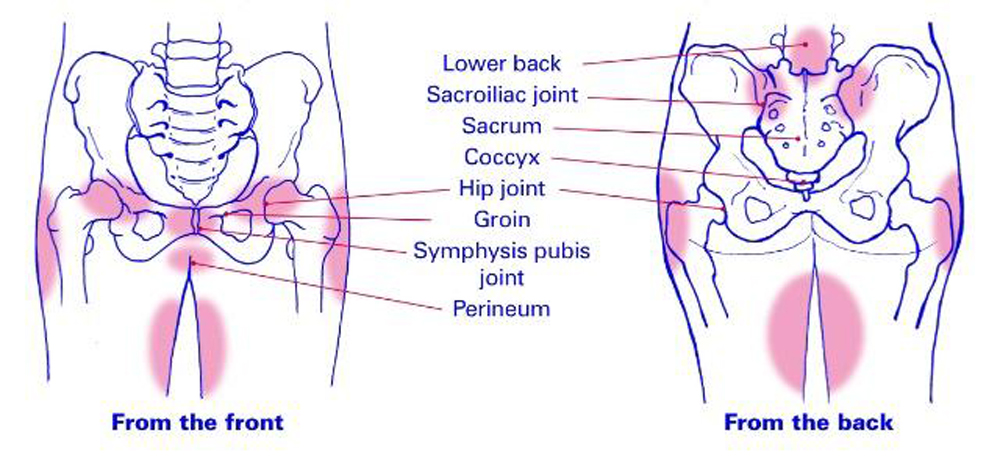Can a Bothersome Course of Pelvic Pain From Mid-pregnancy to Birth be Predicted? A Norwegian Prospective Longitudinal SMS-Track Study
SOURCE: BMJ Open. 2018 (Jul 25); 8 (7): e021378
Stefan Malmqvist, Inger Kjaermann, Knut Andersen, Anne Marie Gausel, Inger Økland, Jan Petter Larsen, Kolbjorn S Bronnick
The Norwegian Centre for Movement Disorders,
Stavanger University Hospital,
Stavanger, Norway.
OBJECTIVE: To explore if pregnant women with pelvic girdle pain (PGP), subgrouped following the results from two clinical tests with high validity and reliability, differ in demographic characteristics and weekly amount of days with bothersome symptoms through the second half of pregnancy.
DESIGN: A prospective longitudinal cohort study.
PARTICIPANTS: Pregnant women with pelvic and lumbopelvic pain due for their second-trimester routine ultrasound examination.
SETTING: Obstetric outpatient clinic at Stavanger University Hospital, Norway.
METHODS: Women reporting pelvic and lumbopelvic pain completed a questionnaire on demographic and clinical features. They were clinically examined following a test procedure recommended in the European guidelines for the diagnosis and treatment of PGP. Women without pain symptoms completed a questionnaire on demographic data. All women were followed weekly through an SMS-Track survey until delivery.
PRIMARY AND SECONDARY OUTCOME MEASURES: The outcome measures were the results from clinical diagnostic tests for PGP and the number of days per week with bothersome pelvic pain.
RESULTS: 503 women participated. 42% (212/503) reported pain in the lumbopelvic region and 39% (196/503) fulfilled the criteria for a probable PGP diagnosis. 27% (137/503) reported both the posterior pelvic pain provocation (P4) and the active straight leg raise (ASLR) tests positive at baseline in week 18, revealing 7.55 (95% CI 5.54 to 10.29) times higher mean number of days with bothersome pelvic pain compared with women with both tests negative. They presented the highest scores for workload, depressed mood, pain level, body mass index, Oswestry Disability Index and the number of previous pregnancies. Exercising regularly before and during pregnancy was more common in women with negative tests.
There are more articles like this @ our:
Chiropractic Pediatrics Section and the:
Clinical Prediction Rule Page and the:
CONCLUSION: If both active straight leg raise (ASLR) and posterior pelvic pain provocation (P4) tests were positive mid-pregnancy, a persistent bothersome pelvic pain of more than 5 days per week throughout the remainder of pregnancy could be predicted. Increased individual control over work situation and an active lifestyle, including regular exercise before and during pregnancy, may serve as a PGP prophylactic.
KEYWORDS: back pain; maternal medicine; musculoskeletal disorders
Strengths and limitations of this study
|
From the Full-Text Article:
Introduction
Pelvic girdle pain (PGP) during pregnancy affects approximately half of all pregnant women, and for 25%–30% the condition becomes severe. [1, 2] The aetiology of PGP is still unknown, and the underlying mechanisms have not been fully investigated. [1, 2] Researchers have explored the physical, psychological and socioeconomic implications of PGP during pregnancy. [3] Pain-related restrictions on physical activity have been described, both during pregnancy and after childbirth, and the psychological impact on perceived health, sexual life and quality of life has been explored, as well as the prevalence of sick leave due to PGP. [3–6]
PGP is classified into specific (caused by trauma) or non-specific (multifactorial). [3] Several clinical tests are needed to diagnose the latter, including pain provocation and functional ability tests. However, there is still no ‘gold standard’ for diagnosing PGP. The European guidelines present evidence-based recommendations for the diagnosis and treatment of PGP, but inconsistencies on the definition as well as treatment still prevail. [3, 7]
Classification of PGP can, according to guidelines, only be reached after lumbar causes have been excluded through a clinical examination. [7] All tests recommended in the European guidelines have a very high specificity, but generally a low sensitivity. Hence, it is recommended to perform all the tests, as one negative test is not sufficient to rule out PGP. [7] The posterior pelvic pain provocation test (P4), for diagnosing sacroiliac joint dysfunction, and the active straight leg raise test (ASLR), for detecting failing force closure, have shown high validity and reliability. [8–10] In a Swedish study, substantial agreement between examiners using ASLR and P4 tests was found in discriminating non-specific lumbopelvic pain into lumbar pain and PGP in pregnant women. [11] Together with a description of pain location, these tests are considered relevant when evaluating affliction in pregnant women likely to have PGP. [12]
So far, the longitudinal course of PGP in pregnancy is incompletely examined. In prospective studies data are usually collected at baseline and at one or a few follow-ups. Measuring only at a few points in time may indicate stability in the examined condition, and a fluctuating course may be missed. A difference could reflect only a temporary fluctuation in an otherwise stable condition. Accordingly, a more frequent data collection is warranted to accurately describe the clinical course. Mobile phones and text messages have previously been found feasible when collecting frequent longitudinal data in clinical settings. [13–15] Phones are usually at hand in daily life; hence, this method yields a high response rate for weekly measures.
The objective of this study was to explore if pregnant women with probable PGP, subgrouped following the results from two valid and reliable clinical tests recommended in the European guidelines, differ in demographic and clinical characteristics at mid-pregnancy and in weekly amount of days with bothersome symptoms through the second half of pregnancy. The hypothesis was that sacroiliac dysfunction and failing force closure diagnosed at mid-pregnancy may predict a course of bothersome symptoms through the second half of pregnancy.
Read the rest of this Full Text article now!







Leave A Comment